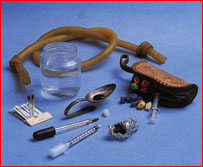|
|
Black Tar Heroin
 Black
tar heroin is mainly produced in Mexico. Black tar heroin may be sticky like
roofing tar or hard like coal. The color may vary from dark brown to black.
The color and consistency of black tar heroin result from the crude processing
methods used to illicitly manufacture heroin in Mexico. Black tar heroin is
often sold on the street in its tar-like state at purity ranging from 20 to
80 percent. Commonly, black tar heroin is sold in small foil or cellophane packets
or in small toy balloons. To develop customers quickly, dealers may specifically
target methadone clinics. These clinics are where heroin addicts receive the
drug methadone, which blocks their need for heroin. These individuals become
easy prey for the dealer and frequently become regular clients. The potency
of street heroin is rarely known and overdose often results. Black
tar heroin is mainly produced in Mexico. Black tar heroin may be sticky like
roofing tar or hard like coal. The color may vary from dark brown to black.
The color and consistency of black tar heroin result from the crude processing
methods used to illicitly manufacture heroin in Mexico. Black tar heroin is
often sold on the street in its tar-like state at purity ranging from 20 to
80 percent. Commonly, black tar heroin is sold in small foil or cellophane packets
or in small toy balloons. To develop customers quickly, dealers may specifically
target methadone clinics. These clinics are where heroin addicts receive the
drug methadone, which blocks their need for heroin. These individuals become
easy prey for the dealer and frequently become regular clients. The potency
of street heroin is rarely known and overdose often results.
 Black
tar heroin is most frequently dissolved, diluted, and then injected. Black tar
heroin addicts place a small amount of black tar heroin in a spoon. The spoon
they use is bent so that it sits level without spilling when placed on a table.
Then they add a small amount of water and it is heated over a flame. Once the
black tar heroin has melted, it is drawn up into a syringe and injected. This
method of administration poses special problems because of the transmission
of HIV and other diseases that can occur from sharing needles or other injection
equipment. Paraphernalia for injecting black tar heroin includes hypodermic
needles, small cotton balls (used to strain the drug), water, and spoons or
bottle caps used for "cooking" or liquefying the heroin. The high
from black tar usually lasts from four to six hours. Black
tar heroin is most frequently dissolved, diluted, and then injected. Black tar
heroin addicts place a small amount of black tar heroin in a spoon. The spoon
they use is bent so that it sits level without spilling when placed on a table.
Then they add a small amount of water and it is heated over a flame. Once the
black tar heroin has melted, it is drawn up into a syringe and injected. This
method of administration poses special problems because of the transmission
of HIV and other diseases that can occur from sharing needles or other injection
equipment. Paraphernalia for injecting black tar heroin includes hypodermic
needles, small cotton balls (used to strain the drug), water, and spoons or
bottle caps used for "cooking" or liquefying the heroin. The high
from black tar usually lasts from four to six hours.
Southern California, primarily Los
Angeles, is a major transportation and distribution hub for Mexican black tar
heroin and brown powdered heroin. The black tar is destined for drug markets
in California and throughout the United States. Nearly all of the heroin produced
in Mexico is destined for U.S. distribution. Mexico-based heroin continues to
dominate the market in the western half of the United States. Evidence suggests
that trafficking organizations from Mexico are attempting to produce higher
purity heroin. Mexican heroin distribution networks in the United States are
managed almost entirely by criminal organizations operating from Mexico and
by Mexican-American criminal gangs that are in charge of the street-level distribution
of heroin. In the past, couriers typically smuggled only small quantities of
heroin across the U.S.-Mexico border. Now, however, heroin is being smuggled
in larger amounts as indicated by the seizure of larger shipments.
Alcohol Effects
Alcohol Statistics
Black Tar Heroin
Cocaine Abuse
Cocaine Symptoms
Crack Cocaine
Drug Abuse Intervention
Drug Abuse Pregnancy
Drug Abuse Symptoms
Drug Alcohol Abuse
Drugs and Driving
Drugs in School
Heroin Overdose
Methadone Addiction
Residential Treatment
Teen Drug Abuse
Club Drugs
Cocaine Addiction
Drug Addiction Facts
Drug Addiction Statistics
Drug Overdose
Getting Help
GHB
Hallucinogens
Harmful Effects of Drug Addiction
Heroin Addiction
Tranquilizers
What are Amphetamines
Drug Schedule Chart
Substance Abuse
Drug Trafficking in the United States
|
|
|